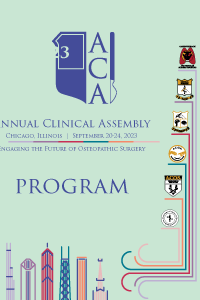General Surgery
Surgical Management of a Low-Grade Appendiceal Mucinous Neoplasm: A Case Report
- JL
Jennie Luu
University of the Incarnate Word School of Osteopathic Medicine
San Antonio, Texas, United States
Primary Presenter(s)
Appendiceal mucinous neoplasms (AMNs) include a group of tumors comprising less than 1% of all cancers. 1 Our study focuses on low-grade appendiceal mucinous neoplasms (LAMNs), defined as dysplastic tumors with abundant mucin that grows to push along the borders of the appendix but lacks invasion and is bound within the muscularis propria. 2 This case report documents the management of a 74-year-old female with cholecystitis with interval dilation of her appendix. Cholecystectomy and appendectomy were performed, and a low-grade appendiceal mucinous neoplasm (LAMN) was found.
Methods or Case Description:
This is a 74-year-old female who initially presented to the emergency department with sudden onset nausea and right lower quadrant abdominal pain. She had no associated fever, diarrhea, or emesis. She was afebrile, stable vitals, and mild leukocytosis of 11.19K/uL. An abdominal and pelvic CT showed cholelithiasis without cholecystitis and a 1.2cm dilated appendix without periappendiceal fat stranding. She was admitted to the hospital and started on IV antibiotics for suspected appendicitis. The next day, the surgical team treated non-operatively after symptoms resolved the following day. She was discharged home with one week of oral antibiotics.
The patient returned to the ED four months later with sudden onset right-sided abdominal pain. The pain was sharp and intermittent, but she had no fevers, nausea, or emesis. On physical exam, she was tender in the right upper quadrant pain without signs of peritonitis. A CT of the abdomen and pelvis was completed that showed a fluid-filled dilated appendix now measuring 1.5cm without periappendiceal fat stranding or fluid, raising suspicion for a mucinous appendiceal lesion. A right upper quadrant ultrasound showed gallbladder wall thickening, sludge, and nonmobile stones in the gallbladder neck, concerning for acute cholecystitis. Her labs were significant for a normal WBC, lipase, LFTs, and bilirubin. She was admitted to the hospital and started on IV antibiotics.
Given the concern for acute cholecystitis and the interval dilation of the appendix, she was taken to the operating room for laparoscopic cholecystectomy with an intraoperative cholangiogram and a laparoscopic appendectomy. Intra-operatively, the cholangiogram showed a filling defect in the distal common bile duct. The appendix was notably dilated without any signs of inflammation or perforation and was removed in its entirety.
Post-operatively, she was taken for ERCP with sphincterotomy and stone extraction. The remainder of her hospital course was unremarkable, and she was discharged home on post-op day five. Pathology showed acute and chronic cholecystitis with a low-grade appendiceal mucinous neoplasm, acellular mucin within the subserosa (stage pT3), and negative margins. Her case was presented at a multi-disciplinary tumor board; no additional surgical resection was recommended.
Outcomes:
Treatment of the patient’s initial visit for concerns of appendicitis was treated nonoperatively with IV and oral antibiotics. The decision was based on the results of the CODA trial, which showed that antibiotic treatment was non-inferior to appendectomy in appendicitis patients. 3 LAMNs are commonly incidentally found, and management varies depending on histological staging and extent of disease. 4 Our patient did not require additional surgical management due to her pT3 staging and lack of peritoneal involvement.
Conclusion:
While uncommon, providers should remember to include appendiceal mucinous neoplasms and other appendiceal malignancies in the differential diagnosis for patients presenting with symptoms of appendicitis. Patients should be counseled on the risk of missed neoplastic process if opting for non-operative treatment for appendicitis. Prompt management is necessary and is vital to survival, especially if pseudomyxoma peritonei is involved warranting additional surgeries and chemotherapy. 4
1. 1. Shaib WL, Assi R, Shamseddine A, et al. Appendiceal Mucinous Neoplasms: Diagnosis and Management. Oncologist. 2017;22(9):1107-1116. doi:10.1634/theoncologist.2017-0081
2. 2. Umetsu SE, Kakar S. Staging of appendiceal mucinous neoplasms: challenges and recent updates. Hum Pathol. 2023;132:65-76. doi:10.1016/J.HUMPATH.2022.07.004
3. 3. A Randomized Trial Comparing Antibiotics with Appendectomy for Appendicitis. New England Journal of Medicine. 2020;383(20):1907-1919. doi:10.1056/NEJMoa2014320
4. 4. Van de Moortele M, De Hertogh G, Sagaert X, Van Cutsem E. Appendiceal cancer : a review of the literature. Acta Gastroenterol Belg. 2020;83(3):441-448.

